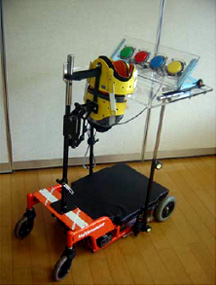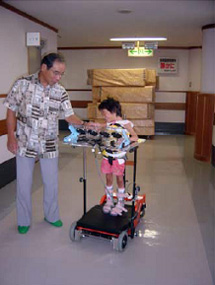8.2 Multilocomotor控制器的改良
Campos来做了2点提议。第一,考虑到她的体力建议每8~10分钟休息一次;第二,考虑到她的上肢技能,建议将操纵杆改为触摸式按钮。
 【触摸按钮式的Multilocomotor】 |
 【练习操作触摸式按钮】 |
现在可以上地方上的保育园,对环境的适应能力开始变好。虽然会说的话只限于"妈妈、拿来、再见"等简单的词汇,但是可以观察到想叫保育园老师和小朋友的名字。并且训练结束后,双手并拢做出"谢谢"的手势。最近,从训练室出来到走廊的时候,开始积极地跟路过的人说再见。对环境的适应能力还非常地弱,但是我们可以帮助孩子慢慢打开"适应环境的窗户"[25]
9.总结
对孩子的发育来说,体验最初的移动经验是非常重要的一步。但是总会有这么一些孩子,因为重度的运动障碍而无法自己行动并体验移动。对这些孩子来说,经常迎面而来的外部环境是如何反映在他们身上,他们又是如何感受外部环境的呢?因为运动障碍,从早期就接受他人帮助,使得孩子的身心经常陷入被动的状态,自己的有用能力、自立能力很容易丧失。所以,这些都会限制孩子自主地参加与他人有关的社会活动。
Beckung,E等人曾对5~8岁的176名脑瘫患儿做过一个关于神经损伤和活动受限及参加活动受制约的调查。结果表明,GMFCS和BFMF之间有很强的关联性,在GMFCS程度V的情况下,将近80%的孩子在运动方面处于困难或是艰难的境地;教育方面,大部分的孩子情况重度;但是在社会性方面,10%的孩子为中度障碍。在BFMF程度Ⅳ的情况下,运动方面,有66%为重度障碍,有10%为中度障碍;教育方面有33%的孩子是中度障碍;在社会性方面,以中度障碍为中心,各种程度的孩子都有分布[26]。从这份报告结果来看,就算患有重度的运动障碍,在社会性方面,也是有可能改善的。
但是在我国,规定电动轮椅费用的报销的年龄限制为7岁以上患者。而且患者本人如不能安全使用机械,那么也无法报销这笔费用。换而言之就是,如果家长不自费出钱,那么早期导入机械系统是有很大困难的。没有制度的话,谁也不会感到有必要做这样的努力。这次,通过使用我们开发的PCSS和Multilocomotor,孩子们体验了很多与环境相关的交流。近年来,跟随着脑科学、机器人工学等科学技术的进步,我们热切地希望参加日本婴幼儿学会的各位老师参与、协助开发一些机械,让患有运动障碍的孩子们可以通过自己的力量愉快地参与到环境中来。
10.谢辞
衷心感谢「财团法人 FANCEBED MEDICAL HOME CARE 研究•助成财团」,有了他们的研究帮助经费,才得以研制开发出了机器。还要衷心感谢研究开发的热心支持者小瑠菜和她的父母。
关于论文中使用到的照片及协助人员的姓名根据个人情报保护法,已经得到了瑠菜双亲的许可刊登。
参考文献
[1] Palisano,R et al:Development of validation of a gross motor function classification system for children with cerebral palsy. Developmental Medicine & Child Neurology 39,214-223(1997).
[2] Mutch, L. Alberman, E. Hagberg, B. Kodama, K, Perat, MV.:Cerebral palsy epidemiology: where are we now and where are we going? . Developmental Medicine & Child Neurology 34,547-551(1992)
[3] http://www.castangfoundation.net/home.asp
[4] Mayston,M :Evidence-based physical therapy for the management of children with cerebral palsy. Developmental Medicine & Child Neurology 47, 795-795 (2005).
[5] Charles JR:Efficacy of a child-friendly form of constraint-induced movement therapy in hemiplegic cerebral palsy: a randomized control trial. Developmental Medicine & Child Neurology 48,635-42(2006)
[6] 今川忠男:发育障碍患儿的新疗法 三轮书店(2000)
[7] Ketelaar,M:Children with cerebral palsy: A functional approach to physical therapy.(Eburon Academic Publishers,1999).(今川忠男监译《针对脑瘫患儿和父母的功能治疗途径》 三轮书店,2004)
[8] Scherzer,A:Early Diagnosis and Interventional Therapy in Cerebral Palsy: An Interdisciplinary Age-Focused Approach, third edition.(Marcel Dekker,2001).( 今川忠男监译《脑瘫的早期治疗》 第2版 医学书院 2003)
[9] Rosenbloom,L:Consequences of impaired movement: A hypothesis and review. In: Holt KS, ed. Movement and Child Development. Philadelphia: Lippincott, 159-162(1975)
[10] Lewis,M:Perceptual-cognitive development in infancy: A generalized expectancy model as a function of the mother-infant interaction. Merrill-Palmer Q 81-100(1969)
[11] Harter,S:Effectance motivation revisited: Toward a developmental model. Human Development 34-64(1978)
[12] Safford,P:Developmental Intervention with Young Physically Handicapped Children. Springfield, IL: Chaeles C Thomas, (1975)
[13] http://www.ninds.nih.gov/index.htm
[14] http://www.twinenterprises.com/cp/
[15] Pountney ,TE:Early developmental of postural control. Physiotherapy 799-802 (1990)
[16] 国吉康夫:《试论胎儿学习和初期认知发育构成论的模式化》 日本婴幼儿学会 第4回学术集会 (2004)
[17] Campos,J.J.:《移动经验创造幼儿的认知世界》新婴幼儿学国际学术大会(2003)
[18] Campos,J.J. Uchiyama,I :Responsiveness to terrestrial optic flow in infancy: does locomotor experience play a role? Human Movement Science. 4-17. (2006)
[19] Butler C:Effects of powered mobility on self-initiated behaviors of very young children with locomotor disability Developmental Medicine & Child Neurology 325-32(1986)
[20] Butler C:Powered mobility for very young disabled children. Developmental Medicine & Child Neurology 472-474 (1983)
[21] Butler C:Effects of powered mobility on self-initiated behaviors of very young children with locomotor disability. Developmental Medicine & Child Neurology 325-332 (1986)
[22] Tefft D:Cognitive predictors of young children's readiness for powered mobility. Developmental Medicine & Child Neurology 665-670(1999)
[23] http://www.canchild.ca/Default.aspx?tabid=36
[24] Imamizu,H:Modular organization of internal models of tools in the human cerebellum Proc Natl Acad Sci U S A. 5461-5466(2003)
[25] Bateson,P:How do sensitive periods arise and what are they for? Animal Behaviour 470-486(1979)
[26] Beckung,E:Neuroimpairments,activity limitations, and participation restrictions in cerebral palsy. Developmental Medicine & Child Neurology 309-316 (2002)












